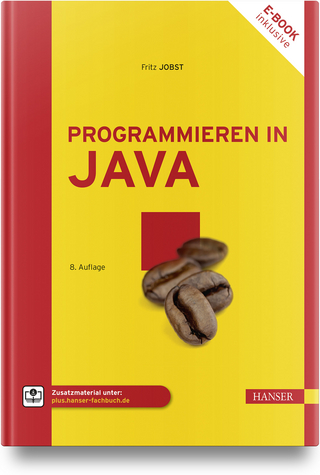
Core Java SE 9 for the Impatient
Addison Wesley (Verlag)
978-0-13-469472-6 (ISBN)
- Titel erscheint in neuer Auflage
- Artikel merken
As with Java 8, Modern Java idioms are no longer required and there is a much faster, easier pathway for learning Java. Horstmann quickly cuts to the chase without lecturing about the superiority of one paradigm over another or rehashing Java history. Given the size of the Java language and the scope of the new features introduced in Java 9, there is a great deal of new material to cover, but it is presented in small chunks organized so that you can quickly retrieve it when needed.
This book covers all aspects of Java that a modern developer needs to know, including modularity, as well as the powerful lambda expressions that were introduced in Java 8. It will also tell you how to find out more about old-fashioned concepts that you might still see in legacy code, but won't dwell on them.
Cay S. Horstmann is the author of Java SE 8 for the Really Impatient (Addison-Wesley, 2014), Scala for the Impatient (Addison-Wesley, 2012), is principal author of Core Java(TM), Volumes I and II, Ninth Edition (Prentice Hall, 2013), and has written a dozen other books for professional programmers and computer science students. He is a professor of computer science at San Jose State University and is a Java Champion.
Preface xxi
Acknowledgments xxiii
About the Author xxv
Chapter 1: Fundamental Programming Structures 1
1.1 Our First Program 2
1.2 Primitive Types 10
1.3 Variables 14
1.4 Arithmetic Operations 17
1.5 Strings 24
1.6 Input and Output 32
1.7 Control Flow 36
1.8 Arrays and Array Lists 43
1.9 Functional Decomposition 52
Exercises 54
Chapter 2: Object-Oriented Programming 59
2.1 Working with Objects 60
2.2 Implementing Classes 65
2.3 Object Construction 69
2.4 Static Variables and Methods 74
2.5 Packages 78
2.6 Nested Classes 85
2.7 Documentation Comments 90
Exercises 95
Chapter 3: Interfaces and Lambda Expressions 99
3.1 Interfaces 100
3.2 Static, Default, and Private Methods 105
3.3 Examples of Interfaces 109
3.4 Lambda Expressions 113
3.5 Method and Constructor References 116
3.6 Processing Lambda Expressions 119
3.7 Lambda Expressions and Variable Scope 124
3.8 Higher-Order Functions 127
3.9 Local and Anonymous Classes 129
Exercises 131
Chapter 4: Inheritance and Reflection 135
4.1 Extending a Class 136
4.2 Object: The Cosmic Superclass 145
4.3 Enumerations 154
4.4 Runtime Type Information and Resources 159
4.5 Reflection 168
Exercises 177
Chapter 5: Exceptions, Assertions, and Logging 181
5.1 Exception Handling 182
5.2 Assertions 193
5.3 Logging 195
Exercises 203
Chapter 6: Generic Programming 207
6.1 Generic Classes 208
6.2 Generic Methods 209
6.3 Type Bounds 210
6.4 Type Variance and Wildcards 211
6.5 Generics in the Java Virtual Machine 216
6.6 Restrictions on Generics 220
6.7 Reflection and Generics 226
Exercises 229
Chapter 7: Collections 235
7.1 An Overview of the Collections Framework 236
7.2 Iterators 240
7.3 Sets 242
7.4 Maps 243
7.5 Other Collections 247
7.6 Views 252
Exercises 255
Chapter 8: Streams 259
8.1 From Iterating to Stream Operations 260
8.2 Stream Creation 261
8.3 The filter, map, and flatMap Methods 263
8.4 Extracting Substreams and Combining Streams 264
8.5 Other Stream Transformations 265
8.6 Simple Reductions 266
8.7 The Optional Type 267
8.8 Collecting Results 271
8.9 Collecting into Maps 273
8.10 Grouping and Partitioning 274
8.11 Downstream Collectors 275
8.12 Reduction Operations 277
8.13 Primitive Type Streams 279
8.14 Parallel Streams 280
Exercises 283
Chapter 9: Processing Input and Output 287
9.1 Input/Output Streams, Readers, and Writers 288
9.2 Paths, Files, and Directories 298
9.3 HTTP Connections 306
9.4 Regular Expressions 310
9.5 Serialization 319
Exercises 325
Chapter 10: Concurrent Programming 329
10.1 Concurrent Tasks 330
10.2 Asynchronous Computations 335
10.3 Thread Safety 341
10.4 Parallel Algorithms 348
10.5 Threadsafe Data Structures 350
10.6 Atomic Counters and Accumulators 354
10.7 Locks and Conditions 357
10.8 Threads 362
10.9 Processes 366
Exercises 371
Chapter 11: Annotations 377
11.1 Using Annotations 378
11.2 Defining Annotations 383
11.3 Standard Annotations 386
11.4 Processing Annotations at Runtime 391
11.5 Source-Level Annotation Processing 394
Exercises 398
Chapter 12: The Date and Time API 401
12.1 The Time Line 402
12.2 Local Dates 404
12.3 Date Adjusters 407
12.4 Local Time 409
12.5 Zoned Time 410
12.6 Formatting and Parsing 413
12.7 Interoperating with Legacy Code 416
Exercises 417
Chapter 13: Internationalization 421
13.1 Locales 422
13.2 Number Formats 427
13.3 Currencies 428
13.4 Date and Time Formatting 429
13.5 Collation and Normalization 431
13.6 Message Formatting 433
13.7 Resource Bundles 435
13.8 Character Encodings 438
13.9 Preferences 439
Exercises 441
Chapter 14: Compiling and Scripting 443
14.1 The Compiler API 444
14.2 The Scripting API 448
14.3 The Nashorn Scripting Engine 452
14.4 Shell Scripting with Nashorn 461
Exercises 464
Chapter 15: The Java Platform Module System 469
15.1 The Module Concept 470
15.2 Naming Modules 472
15.3 The Modular “Hello, World!” Program 472
15.4 Requiring Modules 474
15.5 Exporting Packages 476
15.6 Modules and Reflective Access 479
15.7 Modular JARs 482
15.8 Automatic Modules and the Unnamed Module 484
15.9 Command-Line Flags for Migration 485
15.10 Transitive and Static Requirements 487
15.11 Qualified Exporting and Opening 489
15.12 Service Loading 490
15.13 Tools for Working with Modules 491
Exercises 494
Index 497
| Erscheinungsdatum | 03.02.2018 |
|---|---|
| Verlagsort | Boston |
| Sprache | englisch |
| Maße | 180 x 230 mm |
| Gewicht | 916 g |
| Themenwelt | Informatik ► Programmiersprachen / -werkzeuge ► Java |
| Informatik ► Software Entwicklung ► Objektorientierung | |
| Mathematik / Informatik ► Informatik ► Web / Internet | |
| Wirtschaft ► Volkswirtschaftslehre ► Ökonometrie | |
| ISBN-10 | 0-13-469472-4 / 0134694724 |
| ISBN-13 | 978-0-13-469472-6 / 9780134694726 |
| Zustand | Neuware |
| Informationen gemäß Produktsicherheitsverordnung (GPSR) | |
| Haben Sie eine Frage zum Produkt? |
aus dem Bereich



